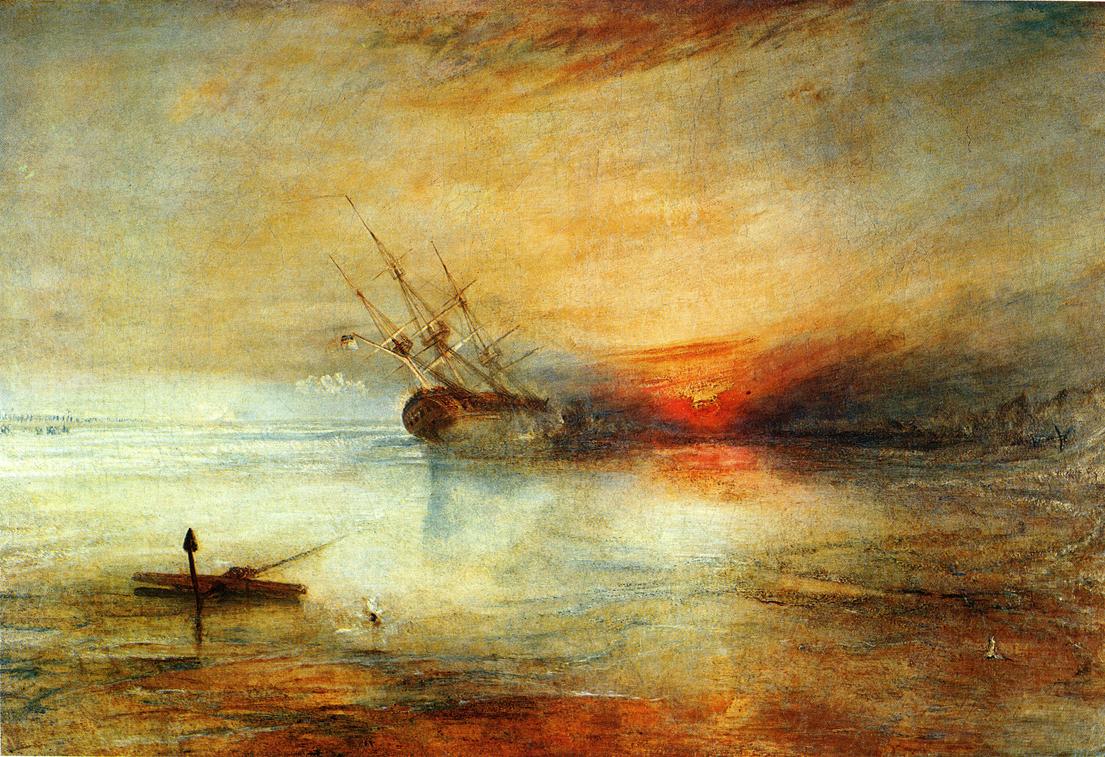Description
"Vividly natural and effective. It can hardly be too admired." These words of La Belle Assemblee reflect the enthusiasm this magnificent painting received when it was exhibited at the Royal Academy in 1831. Turner had always shown an instinctive understanding of the sea, and Fort Vimieux with its bright colors, which are typical of his work. after his first two trips to Italy, he remembers masterpieces such as The Fighting Temeraire (National Gallery) completed seven years later. In fact, it is interesting to note that Fort Vimieux later belonged to the noted American collector James Lenox, the first American owner of any Turner work, who had tried unsuccessfully to persuade the artist to sell him Fighting reckless by any price you could name.
When it was exhibited at the Royal Academy in 1831, Fort Vimieux did not have a specific title in the catalogue, but was accompanied by a lengthy quote:
"In this arduous (Reconnaissance) service on the French coast in 1805, one of our cruisers landed and had to endure the attack of the Flying Artillery along the coast, the Batteries and the Fort of Vimieux who fired hot shot, until he could get away with the rising tide that set in with all the appearance of a stormy night."
Turner is referring to an action off Vimereux (now called Wimereux), just off the coast of Boulogne. During 1804 and 1805 Napoleon had assembled a formidable invasion flotilla which, by July 1805, consisted of 1,337 armed and 154 unarmed ships. These consisted of six large divisions, and the fourth, commanded by Captain Daugier, held the port of Vimereux. During this period, the British fleet was involved in numerous small actions, as attempts were made to tempt French ships into venturing beyond the range of the batteries along the coast. One such action near Vimereux, on the 18th of July 1805, involved a squadron that included the immortality , to the Hebe and to Arab . In 1829 Turner sketched the shoreline and fort in a pen and ink study shown on p. 17 of the CCLX sketchbook in Turner's bequest, where 'Vimereux' is clearly inscribed (see fig.1). It was probably there that he was gathering material for his ambitious plan to illustrate the landscape of the "Great Rivers of Europe" (a project that was eventually limited to French rivers).
The noble ship is represented by Turner lying on his side after running aground off the coast. It has been well secured by two anchors, one in the foreground and one on the distant beach to the right. The sea is calm, and the bright red setting sun illuminates the sky, the sea and the wet sand with a fierce flame. The ship is in a very precarious position, being fired on both from the fort in the distance and from the shore batteries where the view is taken from. Two shots from the latter have come up short and can be seen in close-up, while another shot from the distant fort has struck the ship on her port side. Gunshot smoke can be seen over the horizon. On the promontory to the left, the figures have gathered to watch the incident. The situation has been desperate, but the worst is over because the light will soon go out.
The success of Fort Vimieux it is the result of Turner's lifelong understanding of the sea. He was born within sight and sound of the River Thames, and as a boy of eleven, was sent to stay on the Margate shoreline. His love of the sea at Margate would remain with him throughout his life, and he continued to paint there until his death. His first exhibited oil painting was a marine subject, fishermen in the sea (Tate Gallery), the first engraving after one of his paintings was a marine subject, He shipwreck and his first major commission for a painting was The Bridgewater Mariner. (private collection), one of his largest early marine compositions. He was a keen sailor and keen fisherman, and his sketchbooks contain numerous examples of his fascination with the sea. His personal experiences of the dangers of the sea certainly helped sharpen his observation: a famous early example was in 1802 when he visited France and while landing at Calais his ship nearly flooded. Although the famous quay of calais (National Gallery) is not directly related to this experience, it certainly contributed to the vivid representation of an elemental and uncontrollable sea. It is not surprising to find that in his later works, from the mid-1820s until his death in 1851, there were more marine themes than any other.
Fort Vimieux it is part of a group of paintings in which Turner reacted to Britain's fight against the French in the Napoleonic Wars. As an islander and passionate sailor, he could hardly have remained unmoved by Nelson's triumph and death at Trafalgar. He made a special voyage to sketch the Victory when it entered the Medway and made detailed sketches on board the ship. Soon after he painted the battle of trafalgar (Tate Gallery) as well as victory returning from trafalgar (Yale Center for British Art), and took up the theme again in 1823 with the enormous painting commissioned by the Prince of Wales (National Maritime Museum, Greenwich). painted The Field of Waterloo (Tate Gallery) in 1818, and its 1842 Royal Academy exhibition titled War. The Exile and the Rock Limpet (Tate Gallery) included the figure of Napoleon in exile in Saint Helena.
However, while the theme partly reflects Britain's valiant efforts to prevent a French invasion, the inspiration for the composition of Fort Vimieux it is probably that of Bonington, an artist much admired by Turner. Bonington had died in 1828 and the sale of his studio had taken place in London in June 1829. This sale included several Calais beach scenes and in 1830 Turner exhibited Calais Sands (Bury Art Gallery - see fig.2) at the Royal Academy, a painting that deliberately repeats a theme of which Bonington was an acknowledged master. Calais Sands and Fort Vimieux are the same size and both paintings draw on Turner's appreciation of Bonington's genius, although both also include the Turnerian twist of a fiery sunset. Another painting that is closely related to the composition of Fort Vimieux is A Ship Ground from c.1828 (Tate Gallery - fig.3), where a warship lies on its side in the light of the setting sun, though the image lacks the drama of the later work.
Fort Vimieux it remained in the artist's possession until about 1845, when it was purchased by Charles Meigh of Grove House in Shelton, Staffordshire. Meigh was the grandson of a successful Staffordshire pottery maker, and successfully ran the business himself, supervising the Company's display at the Great Exhibition in 1851. He was said to have a large and valuable collection including works by Reynolds, Gainsborough , Wright of Derby , West, Constable and many Victorian artists. He also owned three Turner watercolors: Maecena's Villa, View of Magdalen College and View of Box Hill, Surrey . The pictures were displayed in a private gallery attached to his home, "one of the largest and best private collections of pictures in the country" ( Art Union , December 1845, p.367). In 1850 it was sold Fort Vimieux , as part of a two-day sale dedicated to the Meigh collection, to the notable Colonel James Lenox, a strict Presbyterian heir to one of New York's great real estate fortunes. Lenox lived at 53 Fifth Avenue and his celebrated book collection was housed in a purpose-built house on Fifth Avenue, designed by Richard Morris Hunt, which eventually merged with the Astor Library to become the main branch of the New York Public Library. . In 1845, Lenox had purchased, directly from the artist, Turner Staffa, Fingals dig (Yale Center for British Art, New Haven), which became Turner's first work to go to America. A few years later, Lenox tried to persuade Turner to sell it. The Fighting Temeraire but without success. Lenox gave his entire collection to the trust that owned his library, and it became the New York Public Library. The current owner's father purchased the painting at the Library sale in 1956.
Turner's contemporaries were enthusiastic about his praise of Fort Vimieux. The critic's words La Belle Assemblee have been cited above, and The Spectator of the 7 of May considered Turner's two seaside scenes to be 'full of beauty'. The most appreciative review was in the Fine Arts Library (i, no-5, p.419):
"The red-hot shot of buckshot, the sun of a bloody hue 'low, deep, and pale,' the forlorn and frightened seagull, the ball whistling in the water, and the stranded ship, present a vivid picture of the event, while the the imagination of set it is great and stupendous. When will Mr. Turner show signs of decay?... his temper is as green as when we first saw him in the childhood of our lives."
Fort Vimieux is ranked no. 86 on the list of famous paintings






